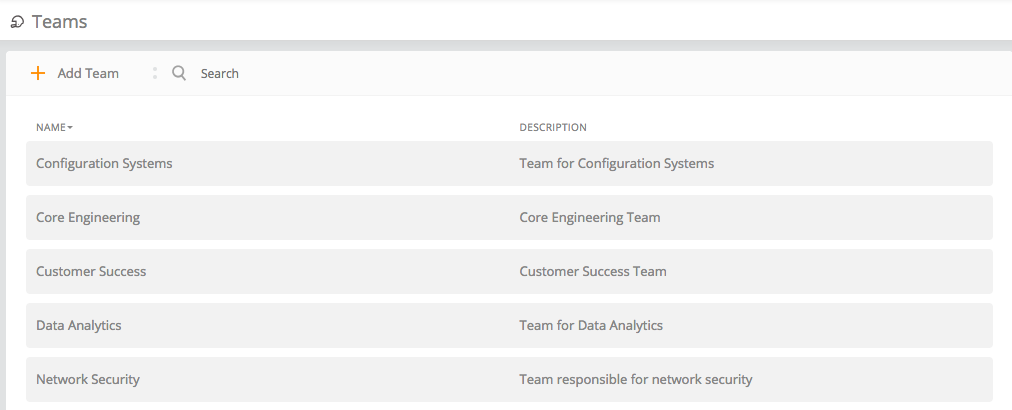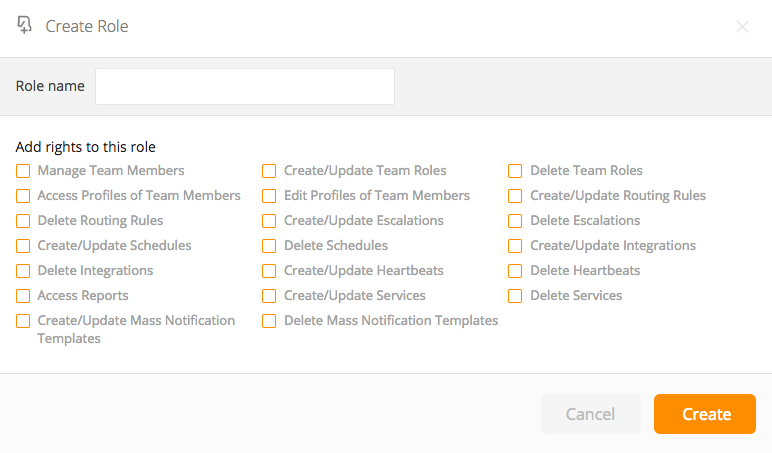Teams
Under the Free and Essentials Plans, the tabs under the Team dashboard are limited to Main, Integrations, Members, and Activity Stream.
Many IT organizations are divided into operational units. This allows them to manage, design and increase the efficiency of their business operations to meet their internal requirements. Some organize by technical specialization, others by activity, some by services, by geography, or any combination of those (or others). Whichever structure the organization chooses, these operational units remain responsible for the problems which occur in their environment.

Create a Team
To create a new Team:
- Access the left sidebar and click the Teams Page. Access the Add Team button (pictured below) at the top of the existing teams list.

- Click Add Team and a form appears.

- Specify the name, description, and begin adding members to your team by typing in the Add Member(s) text box. Invite members to a team by clicking on the bold Invite link. Remember - it is always an option to modify the members and roles on a team by accessing the relevant tabs on the Teams page.
View All Teams
View all teams by accessing the Teams Page via the left main Opsgenie sidebar. It opens a list of all teams.

Editing or Deleting Teams
Edit and delete teams by hovering over team and clicking on the relevant icon (shown below).

Search Teams
Begin typing in the Search bar at the top of the Teams Page to search for a particular team.
Authorization Constraints While Building a Team Segmented Structure
As noted in user roles, account owners and account admins can access, create, modify and delete any configuration within your organization. Furthermore, an account owner/admin can also assign an existing integration, escalation or schedule to a particular team, regardless of whether the configuration is global or already assigned to another team. An account owner/admin can also convert a team-restricted configuration into global.
Team admins without account owner/admin rights can access, create, modify and delete integrations, escalations and schedules only if the configuration belongs to a team that this user is admin of. However, they cannot assign these configurations into another team and they cannot convert these configurations into global.
Team Members
Teams are built up of users and once assigned to a team, they become team members. In OpsGenie, a user can be a member of multiple teams. Note that before adding a user to a team, the user has to first exist in OpsGenie. To accomplish this, users should be invited to your account. They will become enabled/active once they have signed in to OpsGenie for the first time. Users may also be given specific roles on a team. For example, some users may be granted the "Team Admin" role, in order to allow them to handle certain administrative tasks on behalf of the team.
Default Team Roles
Start from the available predefined roles which are appropriate for most use cases. OpsGenie provides two predefined team roles:
- Team Admin
- Team Member
Team Related Right | Team Admin | Team Member |
|---|---|---|
Add / Remove Team Members | ✔ | |
Access and Manage All Team Members' Profiles | ✔ | |
Create/Edit/Delete Routing Rules of the Team | ✔ | |
Create/Edit/Delete Escalations for the Team | ✔ | |
Create/Edit/Delete Schedules for the Team | ✔ | |
Create/Edit/Delete Integrations for the Team | ✔ | |
Access Team's Dashboard | ✔ | ✔ |
Access Escalations, Schedules and Integrations of the Team | ✔ | ✔ |
Access All Alerts of the Team | ✔ | ✔ |
When a team admin without global Edit Configuration user right creates a new escalation, schedule or integration, created configuration will automatically be assigned to the team that the user is admin for. Refer to the Teams and Team Segmentation for further information about the teams and their configurations.
Custom Team Roles
Creating New Custom Team Member Roles
Start crafting a custom team role by granting or dis-granting desired rights. The following figure shows the team member rights that are customizable.

Switch to the Roles tab in the Teams page and existing custom roles are listed. To create a new custom role:
- Click the Add Role button.
- Write a name for the custom role into the Role name field.
- Tick the user rights that you want to grant the users with this role, and un-tick the user rights that you want to prevent the users with this role.
- Click the Add button to save the custom role.
Editing or Deleting New Custom Team Member Roles
Mouse-over an existing custom role in the list and Delete and Edit actions are available.
Updated 7 months ago
